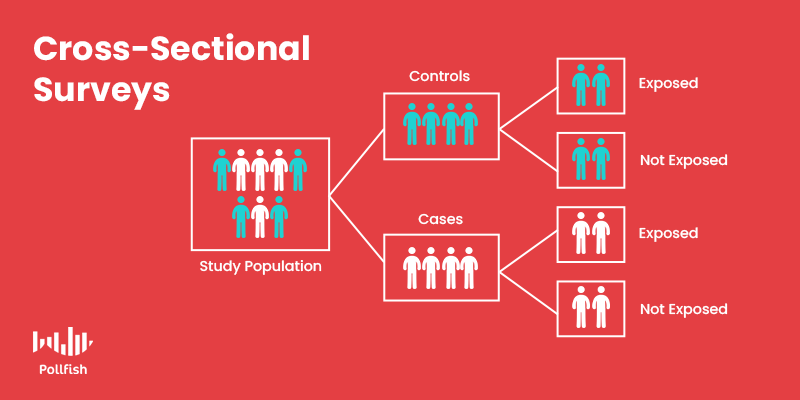Diving Into Cross-Sectional Surveys

There are several survey studies that you can conduct on consumers or on virtually any subject you wish. As mentioned previously, there are three main types of survey research methods: cross-sectional studies, longitudinal studies and retrospective studies.
Fortunately, you can create and customize a survey for each type of survey research method. In this article, we will delve into cross-sectional surveys, which are a part of their own distinct set of survey research: cross-sectional studies.
Mainly used in developmental psychology, this research method expands to a wide variety of other sectors. This includes studying consumers and a business’s target market.
Defining Cross-Sectional Surveys
A cross-sectional study is defined as a study in which research is gathered about a particular population at one fixed point in time. As such, this type of survey research method has been dubbed as a snapshot of a studied population.
This kind of study is conducted via cross-sectional surveys, surveys designed specifically for the cross-sectional model. Using an online survey tool, researchers and business owners can craft their own cross-sectional surveys and deploy them to a specific sample pool.
This type of survey therefore does not require using a survey panel. In fact, it is often contrasted to panel surveys, as they follow a panel over several points in time. Additionally, it runs contrary to longitudinal studies, as they too inspect participants beyond a specific position in time.
The Key Aspects of Cross-Sectional Surveys

To fully understand cross-sectional surveys, aside from their definition solely, you ought to understand their key features. The following lists the core aspects that distinguish these surveys from that of others. Here is how they differ aside from their deployment frequency:
- They are part of observational studies, in which no intervention takes place, only pure investigation.
- They fall under descriptive research, which seeks to describe the what, how, when and where of variables, as opposed to the why.
- They can find current and prevalent attributes in a population.
- They do not manipulate variables.
- They cannot be used to uncover the cause of something, but rather the makeup of a phenomenon or opinions thereof.
- Researchers use them to look at various respondent characteristics, such as age, education, income, gender, etc.)
- They provide an overview of what is occurring in a particular community, situation, etc.
How They Differ from Longitudinal & Retrospective Surveys
Cross-sectional studies are in diametric opposition to longitudinal studies; they are also different from retrospective studies. As such, the surveys for each will differ in design, function, frequency of deployment and purpose.
Unlike cross-sectional studies, longitudinal studies observe a group of people over an extended period of time, as opposed to just over one point. The length of study varies; it can take place anywhere from weeks to years.
Therefore, these studies help put forth a depiction of a sequence of events. These are used to detect changes and developments within the sampling pool. Cross-sectional studies, on the other hand, paint a picture of just one moment in time, usually the prevailing one.
Retrospective studies combine aspects of both cross-sectional and longitudinal studies. They study respondents with surveys that deal with questions about past events. In this way, researchers can compare past feelings and attitudes with those of the present, much like in longitudinal studies.
However, retrospective surveys can be conducted just once, as with cross-sectional surveys. They may amass data on one point in time or several.
Additionally, unlike longitudinal studies, which involve continuous studies, retrospective surveys draw from a pool of an already existing data set. As such, they only deal with events of the past and will not gather any data on new opinions and attitudes that respondents may hold.
It’s important to note that all three of these research methods/survey types are observational, allowing researchers to record and understand the subjects’ behaviors via observation only.
The Types of Cross-Sectional Surveys
There are two types of cross-sectional surveys: descriptive and analytical. Typically, researchers rely on both when conducting this type of study. However, one of these methods may exist entirely on its own.
Descriptive:
A cross-sectional descriptive survey evaluates how frequently, widely, or extensively a particular behavior, phenomenon, attitude or opinion occurs in a demographic group. The findings of each of these categories is thus reviewed and measured on prevalence.
There is a slight distinction made when assessing these different traits in that, when performing studies on the prevalence of something, the study is called a “prevalence study.” On the contrary, when feelings and opinions are analyzed, it is called a “survey.” In either case, surveys can be used to study all of these categories.
Since it is purely descriptive, this method can exist on its own in a cross-sectional study, as opposed to the following study.
Analytical:
An analytical cross-sectional survey probes into the association of two related or unrelated variables. This type of research isn’t entirely infallible, as variables and outcomes are simultaneous, along with their studies.
For example, say you need to find the association between a risk factor and health. Since the risk factor and health result are measured concurrently, with no other variable taken into consideration, it may be difficult to determine whether the risk factor alone contributed to the health outcome. Due to this limitation, analytical studies are usually not conducted alone.
Which Industries Depend on these Surveys for Market Research
There are various industries that depend on cross-sectional surveys for their market research needs. As such, these surveys can serve a wide variety of applications. The following cites several industries that put these surveys into practice.
- General business: In the general business sphere, you can conduct these studies to understand how your target market and its segments react to changes in offerings, along with how you set up marketing, advertising and branding campaigns.
- Healthcare: Researchers may use this survey to study how certain groups of people are prone to certain disorders and conditions, along with how lifestyle changes affect health and much more.
- Retail: Retailers can use these surveys to find trends in relation to spending and how they differ between genders and income levels.

- Psychology: Psychologists can conduct these surveys to study a wide variety of people to understand similarities and differences in their mentality and psyche.
- Education: This survey can help educators understand how students of various grades perform in a new course of study.
- Real estate: Real estate agents and business owners can use these surveys to measure the demand of real estate in particular neighborhoods at the current time.
- Technology: Those in the tech sector can learn the prevalence or existence of certain frustrations and pain points that new SaaS or tech products can help solve.
The Pros and Cons of Cross-Sectional Surveys
Like many other types of survey research methods, cross-sectional studies offer both advantages and disadvantages. It’s vital to consider both of these facets, as they will not merely guide your decision in choosing to use these surveys. They will also allow you to know what to expect if you do use them for your market research needs.
Pros
- Surveying multiple variables shows how differences in income, gender, age, et al. correspond with a critical variable of interest.
- Can be used to prove or disprove assumptions and hypotheses.
- Relatively inexpensive to conduct.
- Fast results despite large amounts of data from a large sampling pool.
- Findings can be used to create new hypotheses, inciting new studies and more thorough research.
- Captures the specific feelings, attitudes and behaviors at a specific point in time.
- Can be used for a wellspring of other research methods (retrospective surveys, market segmentation, branding, etc).
Cons
- Cannot be used to uncover behavior over a period of time.
- Does not determine cause and effect since variables can affect the relationship between the cause and outcomes.
- Cannot be used to find conclusions about causation.
- Results can be biased if there is a conflict of interest (with the funding source).
- Cohort differences can affect groups. (Those born in the same decade may share certain experiences, but those within that group born in a certain area may share only experiences connected to their location).
Questions, Trends and Key Things To Remember
There are a variety of questions pertinent to cross-sectional surveys, as they are descriptive and observational in nature. You would compose them based on the prevailing characteristics you want to unearth or see if there are any correlative qualities behind components like risks, behaviors and outcomes.
As such, there is no list of general questions to ask in these types of studies, as they are specific to populations, variables and their conditions. Investigating the ins and outs of a specific population allows marketers and business owners to understand the relationships between variables. If you need to examine trends, you can repeat these surveys at different points in time. But remember — these surveys should NOT be repeated in the same group of respondents, as they are not follow-up surveys, which are only used in longitudinal studies.
Frequently asked questions
What is a cross-sectional survey?
A cross-sectional survey is conducted to gather information about a studied population at one certain point in time. It is sometimes referred to as a “snapshot” survey.
How does a cross-sectional survey differ from a longitudinal survey?
Performed to examine a population at a specific point in time, a cross-sectional is the opposite of a longitudinal survey, which is conducted to study how certain variables change in a population over a period of time.
What is a descriptive cross-sectional survey?
A descriptive cross-sectional survey is one that measures how frequently or extensively a behavior, opinion, or phenomenon occurs.
What is an analytical cross-sectional survey?
An analytical cross-sectional survey is conducted in order to better understand the relationship between two or more variables.
How are cross-sectional surveys similar to retrospective surveys?
Cross-sectional and retrospective surveys both ask questions about events or occurrences that happened in the past. This helps researchers understand how feelings and opinions change over time.
Pollfish Marketing Team
Ready to Try Pollfish?
Create your survey with AI, target high-quality respondents starting at $0.95 per complete, and start getting results in just minutes in real-time. From running a simple product concept survey to managing a constant stream of trackers for dozens of clients in dozens of countries, we’ve got you.

